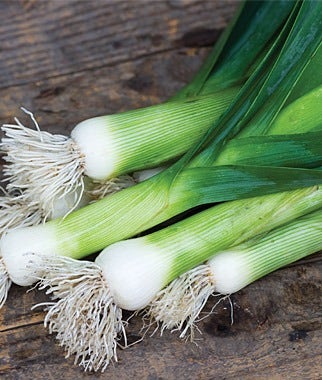We use cookies to give you the best experience on our website. These cookies are completely safe and secure and will never contain any sensitive information. Please read our Privacy Policy. By clicking "Ok" or clicking on any other content, you agree that cookies can be placed.
Leeks Top the Charts
Everything home grown tops any market for quality and freshness. Where else can vegetables be harvested and on the table almost immediately? The garden also beats the market at the cash register and in some cases, by a very wide margin. A prime example is the leek. Cousins of the onion, both are members of the lily family. Leeks have a subtle almost sweet flavor and can either stand alone or be a wonderful addition to many recipes. The bonus is a pack of 500 seeds costs as little as $2.25.
In the market, leeks can bring as much as $4 a pound. That includes the top one-third of the plant that almost always has to be discarded.
Not only are leeks very easy to grow, they can be left in the garden for months and harvested as needed. With a layer of straw or leaves, the plants will do fine through the winter, although it is best to dig them up before they become woody. Days from seed to harvest vary from 98 for Dawn Giant to 130 for Broad London.
To get started, a simple 2- by 10-inch tray about 3 inches tall will do the trick. Fill it to about a half inch from the top with Burpee Seed Starting Formula and scatter the seeds across the surface. In packets with as many as 500 seeds, two trays will be needed. Cover with a quarter inch of starting formula and water thoroughly.
Place the tray on a south facing windowsill. Fold a sheet of aluminum foil to fit under the tray and place a layer or two of paper towel over it. This will prevent any water damage to the sill. There is no need to punch holes in the starting tray, just keep it evenly damp. After 2 to 3 weeks, the seedlings or threads as they are called will appear and there will be lots of them. It isn't necessary to thin the threads unless they are in clumps. Use a pair of tweezers to remove extras. Continue watering until all danger of frost has passed. Then the tray can be place outside during the day for a week to harden off the plants.
If a soil test hasn't been done ever or in the last few years, it's a good idea to call the county extension or agriculture service and have one done. Make the recommended amendments and till the soil.
Trenches at least 6 inches deep can be dug with a small tiller. Dig enough to accommodate the threads spaced about 6 inches apart. They should now be about 4 inches tall. Pile the removed soil to one side of the trench.
To separate the threads, simply remove the entire contents of the starting tray and place it in a bucket of water. A few swishes will have the threads floating free of the soil and easily picked out for planting.
Place the threads in the trench and cover with an inch or two of soil. As they grow, add more soil leaving just the top inch of two of the plant exposed. Continue doing this until the original surface is reached. The bottom of the plants will now be 6 inches underground. Additional soil can be heaped on the plants to increase the length of the usable part of the leek.
Keep the beds weed free and by fall, the green top will be a foot tall or more.
It's best to harvest leeks after the first frost, but there is no need to wait that long. If there are more threads than room to plant them, simple reduce the spacing between the plants and thin as needed for summer salads or for grilling.
Once leeks are tried, they will be a garden staple. Just remember to rotate them and not plant in the same area for two years after the first crop.

